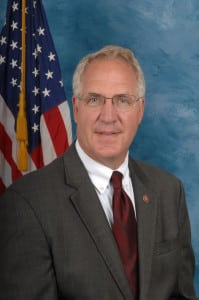
Lawmakers are piling on to co-sponsor a House bill that would smooth the way to open Yucca Mountain in Nye County, Nev., as a permanent nuclear waste repository.
This week alone, 32 additional representatives associated themselves with Rep. John Shimkus’ (R-Ill.) Nuclear Waste Policy Amendments Act of 2017 (H.R.3053): a 45-page bill officially introduced in the House in June after a very public test screening in April before the the House Energy and Commerce environment subcommittee.
That made a total of 107 co-sponsors as of deadline Friday for RadWaste Monitor: 86 Republicans and 21 Democrats.
The full Energy and Commerce Committee approved the bill June 28 by a strongly bipartisan 49-4 vote, setting the stage for an eventual floor vote.
“We’re working to move the bill to the floor as soon as possible,” a Shimkus aide told RadWaste Monitor on Thursday.
Before it gets there, the Congressional Budget Office must score the bill — estimate what it would cost the government if signed into law — and the House Rules Committee must set the rules for floor debate. Neither of those things had happened by deadline Friday for RadWaste Monitor.
Since Congress returned from its summer break after Labor Day, rumors have abounded in Washington that Shimkus’ bill could be headed to the House floor for a vote in October.
Broadly, the legislation would speed the transfer of responsibility for the federally owned Yucca property to the Energy Department from the Interior Department, and clarify that the 147,000-acre site will be used, with a few exceptions, only for nuclear waste disposal.
The first draft of the bill would have allowed DOE to use Nevada’s groundwater at Yucca, and made the federal government solely responsible for granting any air-quality permits needed for building the repository. However, a Shimkus amendment approved by the Energy and Commerce Committee during the June markup stripped out those provisions.
Nevada, where state leaders remain fiercely opposed to the project, has previously used its authority over water rights and air quality at the site to slow DOE’s work at Yucca.
Meanwhile, Shimkus’ bill would make it easier for DOE to partner with a private contractor to build an interim storage facility: a temporary way station for more than 75,000 metric tons of used fuel now stranded at power plants across the country.
If signed into law, the bill would allow DOE to build — but not use — one interim storage site before the Nuclear Regulatory Commission either accepts or rejects the agency’s application to start a permanent waste repository at Yucca. However, DOE could not move any department-owned civilian waste into the interim storage site until the NRC rules on Yucca, or unless there is an emergency that requires such a move.
The bill would authorize funding for an interim storage site over six years, 2020 through 2025, but with a catch: in the last half of that window, DOE would only receive funding for interim storage if it is also spending money on a permanent repository.
For fiscal years 2020 through 2022, the bill would authorize up to $50 million a year for a pre-Yucca interim storage site. For 2023 through 2025, the interim storage site would be authorized to receive funding from the general treasury equal to 10 percent of any amount appropriated in those years from the Nuclear Waste Fund.
The Nuclear Waste Fund is supposed to pay for a permanent nuclear waste repository. Any Yucca appropriation Congress makes — whether for construction or licensing of the repository — must come out that fund. The fund was created in 1983 and had a balance of almost $40 billion in fiscal 2016, according to DOE. The money comes from fees on nuclear power.
The main federal opposition to Yucca Mountain at this point is in the GOP-controlled Senate, which in its fiscal 2018 DOE appropriations bill provided no money for the project. The House’s version of DOE’s 2018 budget bill provides the $120 million the White House requested for Energy Department licensing operations for Yucca, along with $30 million for the NRC. The 2018 fiscal year starts Oct. 1, but a stopgap spending bill approved in September will hold federal budgets at 2017 levels through Dec. 8.